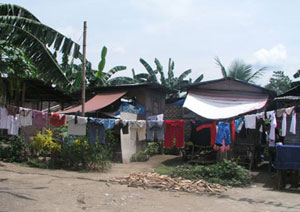“We want to ask the mayor to grant us a relocation site for free,” she told davaotoday.com. She said she�s worried because they are being asked to pay 5,000 pesos for the relocation. �We’re worried because we can’t even come up with 500 pesos, how much more 5,000 pesos?” Elena complained.
The plight of Elena and her neighbors highlights the problem faced by most urban-poor communities in the country, this city included. As it is, they are so impoverished they cannot afford a home, even on the most relaxed loan terms. And if they are booted out of their homes, they don�t have the means to start all over again.
Although the government says it has a housing program that caters to the poor, availing of it requires steady and adequate income, something that most poor urban dwellers like Elena — many of them earning in the so-called underground economy — do not have.

UP FOR DEMOLITION. These homes have been scheduled for demolition. (davaotoday.com photo by Barry Ohaylan)
Thus, critics say, this underscores as well the inherent problem in the Arroyo administration�s housing program: it is unrealistic and is often based on faulty assumptions.
Alfred Depala, the spokesman of the urban-poor group Kadamay in Southern Mindanao, said the government failed to consider the financial capacity of these urban poor communities to avail of the housing program. Only few of those who live in urban poor communities have regular jobs, Depala said. And those that do have jobs do not earn enough to pay the housing mortgage, he said.
“Even if each housing unit costs only 150 or 200 pesos a month, an poor urban poor dweller can still not afford it,” Depala said. Most of what these Filipinos earn go to household expenses such as food, fuel, light and water. The government, he added, cannot expect them to set aside money for a housing unit when that money can be used to buy food on a daily basis.
Under the HUDCC�s low-cost housing program, a house and lot can be had for as little as 300,000 up to two million pesos. These are payable within 10 to 15 years. The Community Mortgage Program (CMP) of the HUDCC provides the funds, which poor families can avail as loans through associations that the communities should organize themselves.
Felix Salino, coordinator for the HUDCC in Southern Mindanao, said this program should address some of the housing shortage.
But Salino himself conceded that only families with regular income can avail of these houses. “The positive thing with the CMP is that the costs are very affordable,� he said. However, he added, �it can accommodate only a few.�
For Depala of Kadamay, that is precisely the problem. “How can a family pay for a house if family members are not even earning enough income in the first place?” Depala asked.
As of April last year, 2.9 million people nationwide are unemployed. The figure can even go as high as 4.4 million, according to statistics.
According to Kadamay, the present 325-peso minimum wage is 114 percent short of the 748-peso estimated daily cost of living for a family of six in Southern Mindanao.
Moreover, the real value of this wage can go as low as 232 pesos, considering the 5.6 percent increase in prices of commodities in June and the rising inflation because of the weekly oil price increases.
The financial difficulties faced by urban poor dwellers have not only resulted in houses not being paid. It also creates problems for the housing program itself, according to officials.
2006: Davao Today's Year-End Series, Poverty









